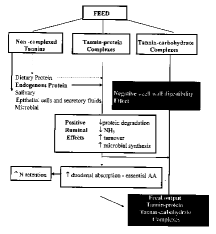|
Submitted to: Journal of Animal Science
Publication Type: Peer Reviewed Journal
Publication Acceptance Date: 8/12/2016
Publication Date: 3/2/2017
Citation: Pake, E., Shreck, A.L., Jennings, J.S., Cole, A., Bailey, E.A. 2017. Effect of condensed tannin extract supplementation of performance, nitrogen, balance, gas emissions, and energetic losses of beef steers. Journal of Animal Science. Vol.95. doi:10.2527/jas2016.0341. Interpretive Summary: Nitrogen emissions from concentrated animal feeding operations are of increasing concern to regulatory agencies and consumers. Condensed tannins are a biological product produced by many plants and may improve nitrogen utilization by cattle thus decreasing nitrogen emissions. Therefore, scientists from ARS (Bushland, Texas), West Texas A&M University and Texas A&M AgriLife Research conducted a study to evaluate the effect of top-dressing a commercially-available condensed tannin extract. Average daily gain and gain:feed ratio were not affected by feeding tannins. Fecal nitrogen excretion was greater but urine nitrogen was less when feeding high levels of tannins. These results suggest that tannin may decrease ammonia losses from feedyards by diverting nitrogen excretion from urine to feces.Technical Abstract: Nitrogen emissions from concentrated animal feeding operations are of increasing concern to regulatory agencies and consumers. We evaluated the effect of top-dressing a finishing diet (14.4% crude protein) for beef steers with a commercially-available condensed tannin extract (CT) at three levels (0, 0.5, and 1.0 % of diet, DM basis). Angus-cross steers (n = 27; initial BW = 350+/-32 kg) were fed individually via Calan gates for 126 days. Diet digestibility and nitrogen (N) balance were estimated after 34 and 95 days on feed (Phase 1 and Phase 2, respectively) using titanium dioxide as a marker of fecal output and creatinine:body weight (BW) ratio as a marker for urine output. Ruminal methane and metabolic carbon doxide fluxes were measured using GreenFeed (C-Lock Inc., Rapid City, SD) for two sampling periods, that coincided with fecal and urine sampling. Urine energy loss was estimated from urine N excretion, assuming all excreted N was urea. Oxygen production was estimated from carbon dioxide production assuming a respiratory quotient of 1.05. Average daily gain (2.08, 2.14, and 2.08 kg/d for 0, 0.5, and 1.0% CT, respectively) and gain:feed did not differ (P = 0.88) among treatments. Starch and organic matter (OM) intake did not differ (P greater than 0.42) among treatments during each phase. Apparent total tract starch digestibility during phase 1 was decreased (P = 0.01) with inclusion of 1% CT. Apparent total tract digestibility of OM and starch were similar (P = 0.13) during phase 2. Nitrogen intake did not differ (P = 0.16) among treatments during each phase, but fecal N excretion was greater (P = 0.05) for 1.0% CT during phase 1. Urinary N excretion was not different (P = 0.39) among treatments during both phases, but urine N as a proportion of total N excretion decreased (P = 0.01) when CT was included in the diet during phase 1. Retained N was not different (P > 0.27) among treatments during each phase. Flux of CO2 were similar (P = 0.37) among treatments during both phases. No differences (P = 0.23) were observed for percentage of gross energy intake lost as methaen (phase 1: 2.99, 3.12, 3.09%; phase 2: 3.54, 3.55, and 4.35%) for 0, 0.5, and 1.0% CT, respectively. No difference (P = 0.42) was observed for heat production lost as a percent of gross enery intake during both phases. The route of N excretion was altered during phase 1; these differences in excretion were not found in phase 2 or into performance, gas emissions, or energetic losses over the entire experiment.
|


